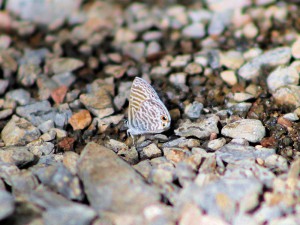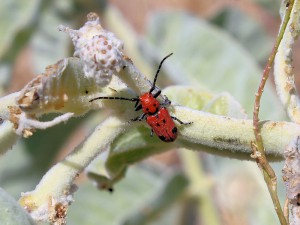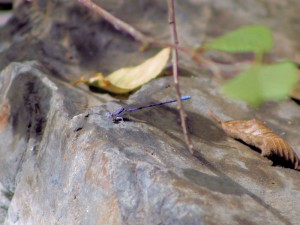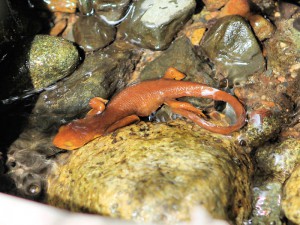The Orange County chapter of the North American Butterfly Association (OC NABA) held its annual butterfly counts this weekend. Counts took place in Thomas Riley Regional Park and O’Neill Regional Park. It was my privilege to participate in the Riley count and to lead the O’Neill count. We had a pretty much ideal day for them, warm and clear without being beastly hot, though a little more moisture to bring on a bloom of more flowers would have been helpful.
As it was, the diversity of butterfly species was a bit on the low side, while the numbers of some species, notably Checkered Whites and Marine Blues were fairly impressive. We had 35 Marine Blues on the Holy Jim Canyon section of the O’Neill count alone, mostly clustering around wet mud puddles. They were difficult to count accurately since they were always moving, and you had to be careful that you didn’t miss something different hiding amongst them. We had a handful of duskywing butterflies, mostly Funereal Duskywings (photo). Many of these were freshly emergent, so the subtle markings in the upper wings and the white trailing edge of the hind wings were particularly bright and well-defined.
It’s Not All about Butterflies
Some of the more interesting things we saw weren’t actually butterflies. A patch of native milkweed along the trail in Riley Regional Park had several interesting beetles on it. First and most obvious, Red Milkweed Beetles (Tetraopes tetrophthalmus) were ubiquitous. These are members of the Long-horned Beetle family, the Cerambycidae. That family includes several other notorious and destructive pest species such as the Pine Bark Beetle. These guys are harmless, feeding primarily on the milkweed plants. Their antennae actually bisect their eyes, giving them four eyes, which is the source of their Latin species name, tetraphthalmus.
Also present on these milkweed plants were another host-specific species, the Blue or Cobalt Milkweed Beetle (Chrysochus cobaltinus). Like the previous species, the Cobalt Milkweed Beetle (photo) is an herbivore, relying primarily on the milkweed plants for nourishment. But it belongs to a completely different family, the leaf beetles, or Chrysomelidae. Both beetles, share lineage with the much more infamous and problematic beetles, in this case, the Japanese Beetle. We had several pairs of these shiny, iridescent green beetles, and they were far more intent on making more beetles than consuming milkweed!
Dragons and Damsels
We also had a number of spectacular dragonflies and damselflies (collectively: “odes”). The pond area of Riley Regional Park was home to Green Darners, both Neon and Flame Skimmers (photo) as well as Roseate Skimmers, a large purplish dragon found across the entire southern USA. Blue-eyed Darners and Wandering Gliders hawked insects in areas more distant from the nearest water. A male Pale-faced Clubskimmer patrolled an area up a dry canyon in O’Neill Regional Park. What a showy dragon it is! Vivid Dancers flock to the wet streams and drainages of O’Neill and Holy Jim Creek. Somewhat more rare, we loved the a lone male Lavender Dancer, hidden in the shadows of Holy Jim Creek.
An active Ash-throated Flycatcher nest in a nest box at O’Neill Regional Park provided a neat diversion. We watched both adult flycatchers feed their noisy young, who remained hidden from view in the bottom of the box. Almost every trip in with food ended with removal of a fecal sack. Whatever goes in must eventually come out! The best non-butterfly of the day was three California Newts in Holy Jim Creek. California or Orange-bellied Newts (Taricha torosa) are large, slow-moving terrestrial salamanders. Like all members of genus, Taricha, these newts produce a very potent neurotoxin, tetrodotoxin. in their skin. Handling them is a bad idea! Puffer fish and harlequin frogs make the same toxin. It’s always good to find California Newts though. Their presence indicates higher water quality in the streams and pools they frequent.




